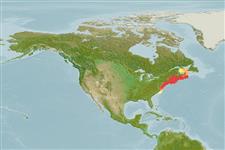Elasmobranchii (sharks and rays) >
Rajiformes (Skates and rays) >
Rajidae (Skates)
Etymology: Leucoraja: Greek, leykos = white + Latin, raja = a fish, Raja sp. (Ref. 45335).
Environment / Climate / Range
Ecology
Marine; demersal; oceanodromous (Ref. 51243); depth range 0 - 329 m (Ref. 5951). Temperate, preferred 12°C (Ref. 107945); 49°N - 33°N, 78°W - 59°W (Ref. 55277)
Western Atlantic: southern Gulf of St. Lawrence and Nova Scotia in Canada to North Carolina, USA.
Length at first maturity / Size / Weight / Age
Maturity: Lm ?, range 32 - 43 cm
Max length : 54.0 cm TL male/unsexed; (Ref. 1126)
Usually on sandy or gravelly bottoms from shoal waters to 90 m depth (Ref. 7251), with temperature range of 1.2-21°C. Benthic (Ref. 5951). Mostly inactive during daylight, but active under dark conditions (Ref. 10807). Feeds on bottom-dwelling organisms such as crabs, shrimps, polychaetes, sea squirts, mollusks, squids and bony fishes (Ref. 27549). Oviparous. Distinct pairing with embrace. Young may tend to follow large objects, such as their mother (Ref. 205). Eggs are oblong capsules with stiff pointed horns at the corners deposited in sandy or muddy flats (Ref. 205). Egg capsules are 4.6-6.3 cm long and 2.7-4.8 cm wide, about 10-35 eggs are laid annually (Ref. 41250). Possesses an electric organ located in the tail region (Ref. 10807). Electric organ discharge (EOD) activity is intermittent (Ref. 10011) and seemed more frequent during dark periods (Ref. 10808). The individual EOD of this species is monophasic, head-negative, and lasts 70 ms (Ref. 10011).
Oviparous, paired eggs are laid. Embryos feed solely on yolk (Ref. 50449). Distinct pairing with embrace. Young may tend to follow large objects, such as their mother (Ref. 205).
McEachran, J.D. and K.A. Dunn, 1998. Phylogenetic analysis of skates, a morphologically conservative clade of elasmobranchs (Chondrichthyes: Rajidae). Copeia 1998(2):271-290. (Ref. 27314)
IUCN Red List Status (Ref. 115185)
CITES (Ref. 94142)
Not Evaluated
Threat to humans
Harmless
Human uses
Tools
Special reports
Download XML
Internet sources
